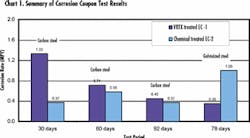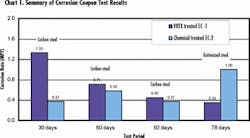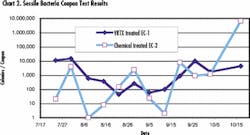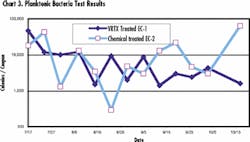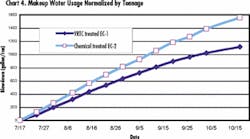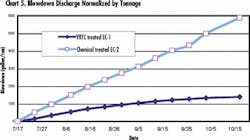Non-Chemical Treatment Helps Control Condenser Scaling
By Dotti Shay, Wiley Wang and Robert Kelsey
The General Mills Bakeries plant in Chanhassen, MN, has two evaporative condenser (EC) systems to cool the ammonia refrigerant needed for food processing and storage. The EC-1 system consists of four IMECO condensers, and EC-2 system consists of five IMECO condensers. The combined cooling capacity of EC-1 system is about 15 percent less than the capacity of EC-2 system. Water is sprayed on the condenser tubes for cooling the refrigerant about 245 days per year.
Due to the heated surface, dissolved hardness in the cooling water tends to scale on the condenser tubes. Bacterial slime and algae also often accumulate there. These deposits reduce the ability of heat to transfer from the condenser tubes to the cooling water, resulting in the waste of electrical energy needed to run the refrigeration systems. Historically, chemical based water treatment was used to minimize these and other problems. But the performance was marginal, even though the makeup water was softened and cycles of concentration were kept low (less than 2). Additionally, there was always a concern over the use of hazardous treatment chemicals in the work place; and the plant internal wastewater treatment plant had complained of the difficulties in treating some of the chemicals used and discharged in the blowdown.
In order to eliminate hazardous chemicals, improve worker safety, and comply with regulatory guidelines, the Chanhassen plant assembled an internal task force to evaluate alternative cooling water treatment methods. Despite the fact that there were several non-chemical methods available on the market, none of them worked satisfactorily and evaluating viable alternatives was a significant undertaken.
In late 1999, a new non-traditional cooling water treatment technology, the VRTX system, was introduced to the market. The system claims the ability to control scale, corrosion, and biological activities in recirculating cooling water without the use of chemicals. In addition, cooling water can run at elevated cycles, so that makeup water usage and consequent blowdown will be reduced. After an extensive internal research, a 60 gpm VRTX system was purchased in May 2000, and installed on the EC-1 system. Makeup water was switched from softened water to city water. Meanwhile the EC-2 system (which remained on chemical treatment) continued to use softened water.
Treatment unit
The VRTX system consists of two main components: a 60 GPM VRTX unit and a filtering system. Both draw and return water to the sump separately. Inline suction strainers were installed prior to both the VRTX unit and separator unit to collect large-sized debris. The VRTX unit works primarily on the principals of Controlled Hydrodynamic Cavitation (CHC). As water is pumped through the unit, the CHC actions destruct microbial cell walls and convert dissolved calcium and bicarbonate ions into aragonite calcium carbonate (CaCO3) colloids. The aragonite CaCO3 colloids form soft deposits and are separated from the recirculating water by the separation unit.
Comparison Study
To verify the effectiveness of the VRTX system, General Mills decided to perform a side-by-side comparison test of the system versus chemical treatment. A team of internal personnel, external companies and state agencies was formed to assess this new technology. The study began on July 14, 2000, and ended on October 17, 2000, which covered the summer season's peak condenser loads.
At the beginning of the study, 30 cold rolled steel coupons and 30 galvanized coupons were installed in each EC system for both corrosion and sessile bacteria analyses. Flow meters were installed at both makeup and blowdown lines, and readings were recorded every week. Water samples and coupons were pulled weekly and were submitted to Spectrum Labs Inc. for analysis. Each system was also inspected regularly for fouling buildups in the sump and on the condenser tubes.
Summary of Results
In general, the two treatment methods, chemical vs. VRTX, showed similar performance characteristics during the 92-day study.
Scale Control
No scale buildup was observed in either system. It should be noted that the makeup for the VRTX treated EC-1 had calcium over 200 ppm (as CaCO3), while calcium in makeup for the chemical treated EC-2 was less than 20 ppm (as CaCO3). Using the VRTX system allowed harder water usage in the cooling system thereby eliminating the need for softened water. Weekly measurements of the sump water indicated average calcium levels of 70 ppm (as CaCO3) in EC-1 recirculating water, demonstrating the continuous removal of calcium by the VRTX system.
Corrosion Control
Both treatment methods showed excellent corrosion control. No pitting was noticed on any test coupons. The initial corrosion rate of carbon steel (after 30 days) was higher in the VRTX treated EC-1 than in chemical treated EC-2, but this difference diminished over the extended test period (at 60 and 92 days). For galvanized steel, the corrosion rates in the VRTX treated EC-1 were only about one third of the rates in chemical treated EC-2.
Bacteria Control
No significant bacterial slime was noted on the tubes based on observations, except for some bacterial discoloration in EC-2 in October 2000. As a result of a chemical feed pump failure, both coupon and sump water showed very high bacteria counts at the end of the study in EC-2. The wide fluctuation of bacterial counts in EC-2 could be caused by the variation in amount of biocides added. During this study, two types of biocides were applied to chemically treated EC-2. One was based on sodium hypochlorite, and the another was a blend of carbamates.
No significant algae growth was identified on any coupons during this study in either system. In October 2000, a green-color biomass was observed on the demister from the chemically treated ER-2 system.
Water Consumption
Over the 92-day test period, the makeup water consumption was 1,113 gallon/ton for EC-1 and 1,559 gallon/ton for EC-2, respectively. This data indicates that the reduction in makeup water is almost 30 percent with the use of VRTX treatment, representing approximately 740,000 gallons of water savings in the 92-day study.
The savings in makeup water comes from the reduction of blowdown discharge. Normalized by tonnages of the two systems, the blowdown from EC-1 was less than 1/4 of the blowdown from chemical treated EC-2.
The cycles of concentration, estimated from the makeup and blowdown data, were 8.0 for EC-1 and 2.6 for EC-2.
Evaporation rates were also calculated from the makeup and blowdown data. The calculated results indicated that the EC-1 had a ~ 5 percent higher evaporation rate than EC-2. Higher evaporation rate was a result of faster heat transfer across condenser tubes, which means improved chiller system performance and less energy consumption. This efficiency increase resulted in an annual energy usage decrease of 1.8 million kilowatt hours.
Conclusion
This study proved that VRTX technology can effectively control problems related to cooling water without the use of chemicals. During the study period, no scale and biofouling were formed on condenser tubes on VRTX treated EC-1 system, despite the very hard city water being used as makeup. Corrosion rates were also kept at very low levels for both carbon and galvanized steel.
During the study period of July 17 to October 17, 2000, VRTX treatment eliminated $16,997 in chemicals and $912 of softener salt. The combined water/sewer cost savings were about $4,129, along with reduction in energy consumption. A one-time Sewer Availability Charge (SAC) of $17,976 could also be saved. The payback period of VRTX, in this case, is less than 2 years. If the reduced SAC fees are included, the system would pay for itself within a year.
As a result of this study, a second VRTX system replaced chemical treatment for EC-2 at the end of Year 2000. The annual water usage was reduced approximately 3,674,000 gallons in Year 2001. The total annual savings, including treatment chemicals, water/sewer, and electricity consumption, are $108,000 by implementing VRTX treatment at this facility.
About the authors: Dorthea (Dotti) Shay is General Mills Environmental Coordinator for the Chanhassen and Eden Prairie Plants. Robert Kelsey is the Vice President/General manager of VRTX Technologies, a new division of A.W. Chesterton Co. Wiley Wang, Ph.D. is Senior Chemist at VRTX Technologies where he is responsible for all research and development activities.
